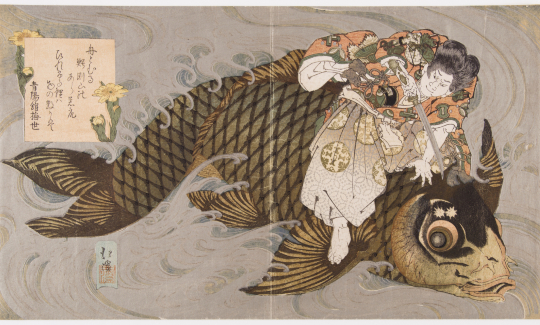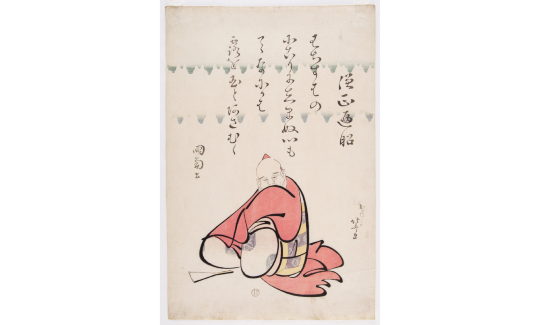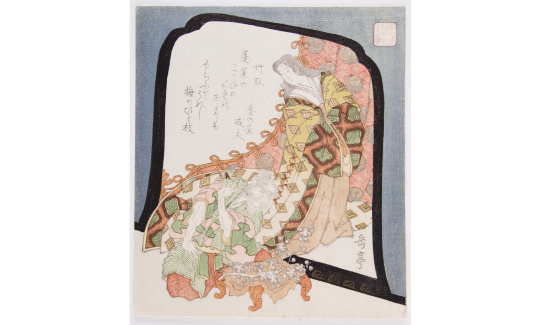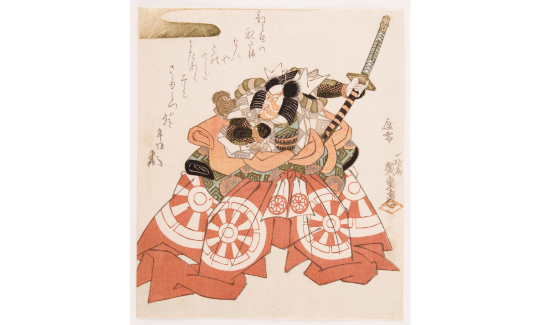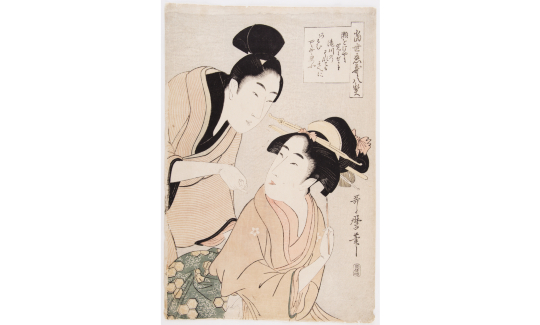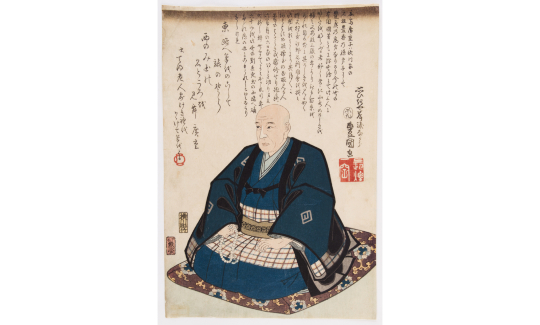In China, ideograms developed from paintings, and the script became integral to the work of art, especially to painting. In a 1st century BCE Chinese dictionary, the ideogram for ‘writing’ and ‘painting’ is the same, and represents a hand holding a brush, drawing a frame round a space. Many strokes characteristic of simple script are also used in painting. The Japanese adopted the Chinese characters in the 6th century. Even today, the meaning of the Japanese word kaku is both ‘to paint’ and ‘to write’, though they are written with two different characters. Thus calligraphy and painting are closely associated, both in China and in Japan.
In early ink drawings it was customary to include gasen (writing). Gasen is original prose or verse, or a quotation from classical literature or poetry. In some instances, the text is added by a friend or admirer of the artist, and in others by the artist himself. Beneath the text the signature and seal of the poet are added. It was customary for Zen masters to add words of encouragement or praise for their pupils to a painting, which were then given as gifts in appreciation of the students’ achievements.
In the early 15th century, the shigajiku (poem-picture scroll) was a favourite mode of expression in Japan. These were usually landscapes accompanied by poems. Shigajiku evolved in the five Zen mountain temples (gozan) of Kyoto. A famous shigajiku, is by the Zen monk Josetsu (active ca. 1386?-1428?) of “Catching Catfish in a Gourd” in the Taizôin Temple. Poems by thirty Zen monks are inscribed in the upper section of the painting. Many works are attributed to the artist Shûbun, active 1414-1463 in the Muromachi era (1333-1573), and these too include writings by Zen monks. Similar to the shigajiku are the shosaijiku or shosai-zu – painted scrolls depicting monks studying in isolated retreats or monasteries, with a poem in the upper section. Sobetsujiku scrolls also include pictures and poems, and depict the sadness of a family member departing from home to lead a monastic life. When the Japanese artist Sesshû (1420-1506) travelled to China to paint scenery there from personal observation, the association of Zen monasteries with ink painting and literature decreased, and paintings without texts began to appear.
Poetry has been part of Japanese culture since the dawn of civilization. Even the 8th century historical epic Kojiki (‘Records of Ancient Matters’) includes poems. The first Japanese poetry anthology, the Manyôshû (‘Collection of Ten Thousand leaves’), also from the 8th century, contains more than 4000 poems, each with 5–7 stanzas, some short, some longer. After the Manyôshû, the long poem was replaced by the tanka (short poem), also known as waka (Japanese poem). The tanka has 31 syllables (7-7-5-7-5), does not usually rhyme, and comprises two themes – descriptions of scenery and of the poet’s emotions. In the Heian era (794-1185), poetry contests were held at the emperor’s court, and anthologies like the Kokinshû (Anthology of old and new Japanese poetry, 905) were compiled at his command. In the same period, in addition to the traditional tanka, we also find the kanshi – the Chinese form – which has a standard number of syllables in each line (4,5,7,8 or more) and no syntactical connection between the lines, which generally rhyme. The haiku, composed of 17 syllables (5-7-5) developed in the 16th century, is an abbreviated form of the tanka, reflecting the mental outlook of the poet in natural scenes intended to convey emotions, thoughts, and moods. Two other poetic modes that also developed were the kyôka (crazy poem), and the senryû, so called after the poet Karai Senryû (1718-1790). The kyôka is a satirical tanka, while the senryû is a humorous haiku that is sometimes shorter than the standard. The comic tanka became very popular in the 17th and 18th centuries in Kyoto, and later in Edo (today Tokyo). The kyôka depends largely on word play, double entendres, and imitations of classic poetry. However, it lacks the more countrified simplicity typical of the senryû. The first kyôka anthologies were published in Kyoto circa 1760. Chinese poetry, and humorous versions of it, the kyôshi (crazy Chinese poems) were also frequently integrated as gasen.
During the Edo era (1603-1868), the long tradition of poem-paintings also began to appear as ukiyo-e (pictures from the floating world), the woodblock print genre. Most of the early prints were black-and-white, and the subjects were usually kabuki actors or courtesans. Often they were without the signature of the poet, and these poems can be attributed to the actors or courtesans depicted. In other instances, the connection between painting and poem derived from the need to mark specific events, such as - the first performance by a kabuki actor in Edo; changing the actor’s name, or if the actor appeared in a particularly long drama. Most of these prints were created by artists of the Torii school.
Poetry was integral to life in Edo, and all strata of society, from samurai to courtesan, wrote poems. This feeling for poetry gave rise to many poets’ clubs and groups. In 1769, a group of poets came together to write poems, among whom were Karagoromo Kisshû (1743-1802) and Yomo no Akara (1749-1823), also known by his pen name, Ôta Nampo. Thus the kyôka club was formed. The poets frequently invited an artist to illustrate the subject selected for composition, and this in turn gave rise to the surimono (‘something printed’) prints. Most artists of the time who created surimono (greeting cards or invitations to performances or concerts) wrote poetry and belonged to such clubs. Kisshû wrote in his journal that each poet would bring a decorated cloth or a fan with a poem on it to the meetings. In the 1760s, the kyôka was very popular in Edo. Poets, artists and tradesmen alike wrote kyôka that influenced the popular art of the time.
Although ukiyo-e is considered a popular art form, it is still closely linked to the classical Japanese culture. This is evident in the integration of classic tanka poems in the paintings or prints, many of which illustrate the content of the text or the circumstances of its composition. Classical Japanese literature is full of poetry. Many woodblock prints from the ‘floating world’ comprise these original poems, episodes from the 10th century ‘Tale of Ise’, and poems by Ariwara no Narihira (825-880).
An innovation of the Edo period was illustrating poetry anthologies. The best known of these is "One Hundred Poems of One Hundred Poets" (Hyakunin isshu). From 1835 to 1838, Katsushika Hokusai published the series, ‘One Hundred Poems by One Hundred Poets as explained by a Wet-Nurse’. A wet-nurse was an uneducated woman, so we can assume that Hokusai dealt with the subject in a humorous fashion.
Another famous series that includes poems is the Ômi hakkei (Eight Views of Ômi) by Utagawa Hiroshige (1797-1858). Ômi is the area near Lake Biwa. Possibly the inspiration for these prints was a series of 11th century Chinese paintings, depicting ‘Eight Views of the Xiao and Xiang Rivers’, and which include poems written by a Zen monk. A tradition also arose in Japan of meisho-e (‘pictures of famous places’) in the Heian era. Some scholars think that Konoe Masaie (1444-1505) and his son Hisamichi (1472-1544) chose the sites for the Ômi hakkei and composed the poems, but many of today’s experts believe that they were written by the calligrapher Konoe Nobutada (1565-1614). At Enman’in, the temple at Miidera, there are two folding screens decorated with representations of Ômi and with poems by Nobutada, which are thought to be the earliest works on the subject. At the beginning of the 17th century, the same subject became part of the repertoire of the Kanô School connected with the military regime, and of the Tosa School at the court of the emperor. One of the early ukiyo-e artists was Nishimura Shigenaga (1697?-1756), who created four different series of prints on this theme. Perhaps Ishiyama was the place most frequently depicted in the series because, according to tradition, Murasaki Shikibu wrote her Genji monogatari (Tale of Genji) at the temple, completing it in 1008. A print by Kuniyoshi shows the temple’s main hall looking out across Lake Biwa, with a full moon shining between the clouds: “Ishiyama! / The moon shining / over Niho Bay / is the very same / as at Suma and Akashi.” The poet imagines Murasaki in the temple at Ishiyama watching the moonlight on Lake Biwa the very same moon that shines over the sea at Akashi near the inland sea, and which also shines on Suma near Osaka where Prince Genji, the novel’s hero, was in exile.
Japanese artists did not confine themselves to ‘Eight Famous Views of Ômi’. They illustrated other series of views and poems about the districts of Japan. Kanazawa was one of these, and the print “Autumn Moon at Seto” comes from his series.
The Six Tamagawa Rivers (Jewel Rivers) were also popular subjects for woodblock prints. Each print deals with a specific scene or an event that occurred there. In the Tetsukuri no Tamagawa print, for example, the poem emphasizes the taste of the water flowing towards the temple on Mount Koya: “Despite the warning, / Despite the bitter taste, / The traveller to Okuno in Takano / Gulps the water from Tamagawa River.” Apparently, the rivers are valued for their potability, though a notice beside them warns against drinking because the water is polluted by poisonous insects. The poem suggests tasting it first.
Laments for death also appear in the prints and paintings. Toyokuni III’s portrait of Utagawa Hiroshige incorporates a biographical text about the latter, written by the poet and author Tenmei Rôjin. On the left is the following poem: “I leave / my paintbrush in the East, / travelling skies / I long to see / the famous Western Land.” To the east lies Edo, Hiroshige’s homeland. According to Buddhist belief, the Western Land is Paradise.
In the 17th century the haiga appeared, a combination of haiku and spontaneous ink painting. Some of the gasen (texts) on these works were considered of more value than the paintings themselves, which led to detaching them and displaying them on a separate scroll.
The Hebrew translations of the poems in the exhibition are indeed in a style free from the constraints demanded by the Japanese poetic form. Each word has been carefully and sensitively chosen. I have also tried to render and place the words in their original poetic order.

